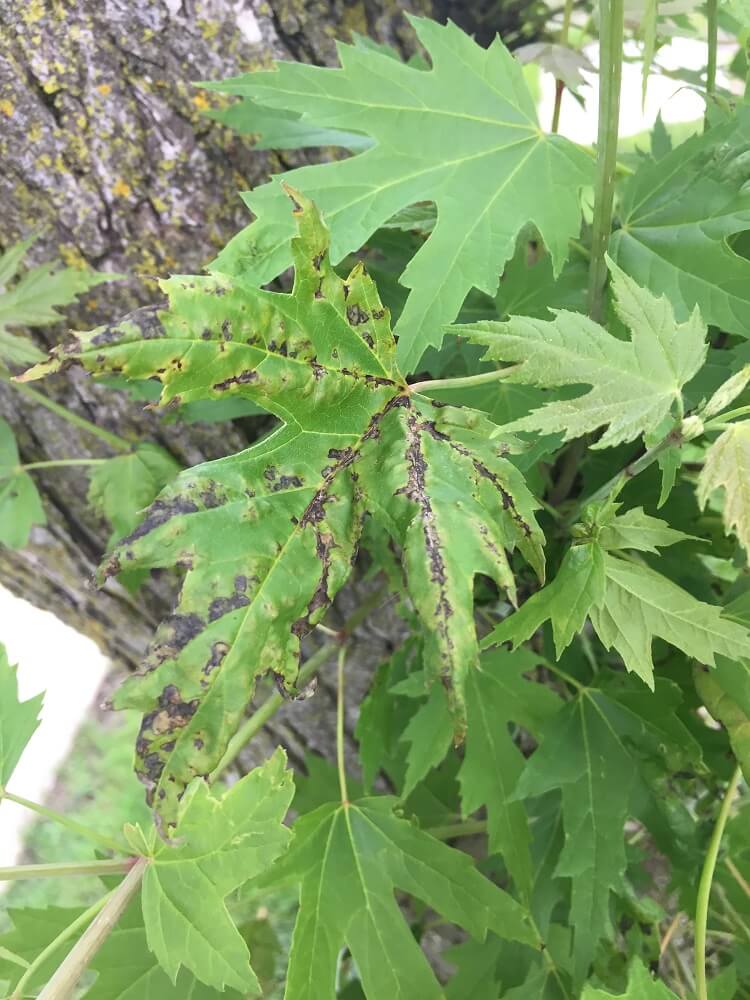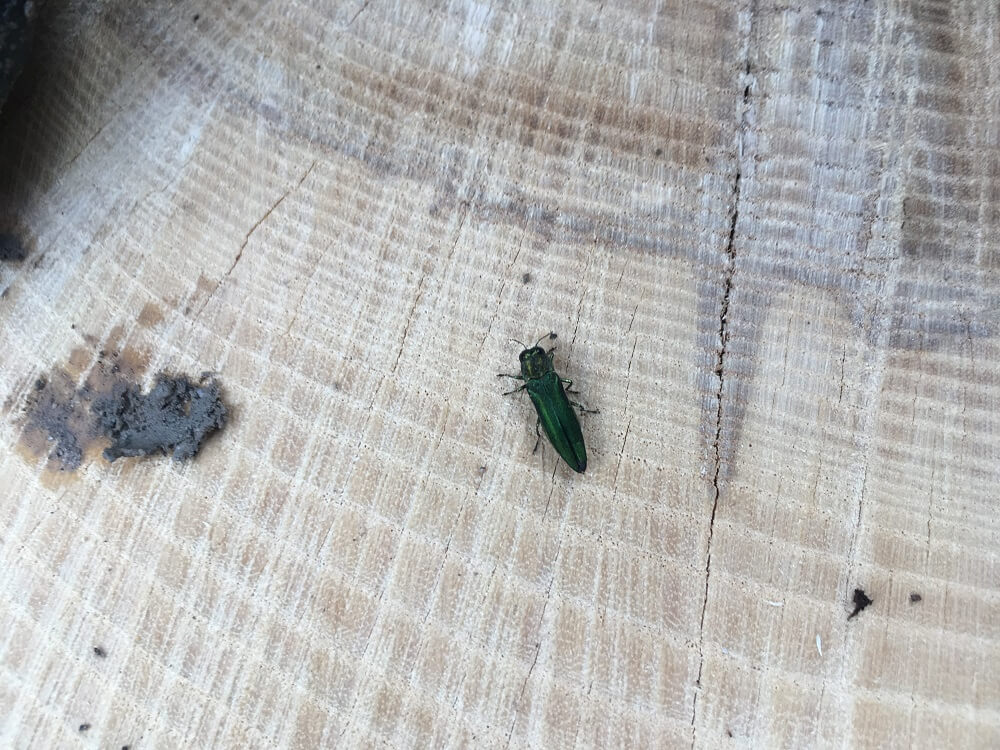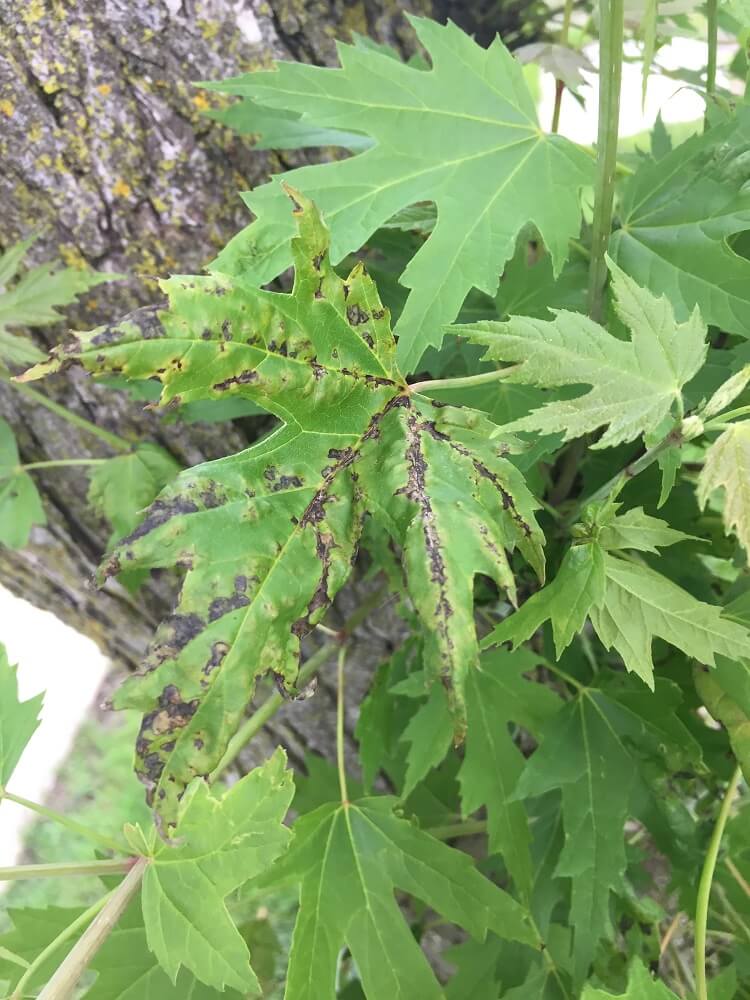
It is important to be aware of the warning signs and symptoms of these common pests, in order to ensure that your property’s tree remain healthy. If you think you spot a problem with your tree, contact us at Baum Tree Care and we will send one of our professional arborists to confirm whether you are at risk.
Here is a list of common pests to look out for on your trees in Ontario:
Tar Spot
Tar Spot (Rhytisma acerinum) is a fungal infection that usually becomes apparent between mid-summer and fall, when the pale spots on the leaves that formed earlier in the season turn dark brown or black.
Tar spot will affect species of Maple and Sycamores. It is most commonly found on Norway Maple, but it can be found on Silver and Red Maple as well. Although unsightly, tar spot does little harm to the tree. Removing tar spot infected leafs from around the base of the tree in the fall can help limit its growth the following year.
Black Knot
Black knot is an aggressive fungus (Apiosporina morbosa) that effects species in the genus Prunus (Cherry, Plum, etc.). The black knot fungus appears as swollen black growths on the branches of the tree. It affects the esthetics of the tree and when it takes over, it can eventually kill the tree.
Pruning out black knot is usually an effective management tool, but you must be cautious to not reinfect the tree. Each cut made to remove the infected branches should be made well below the fruiting body (the black lumpy branch) and you should be careful to disinfect your cutting tool with each and every cut made.
At Baum Tree Care, we use Lysol or bleach to disinfect our tools and wipe the blades of the saw or pruners with each cut. After you are finished pruning thoroughly, you should disinfect your tools again and place the infected branches in a black plastic garbage bag and tie tightly or burn to prevent spores from travelling on the wind.

Pruning out black knot is best done while the tree is dormant. This prevents the spores from having a chance to re-infect the tree.
Emerald Ash Borer
Emerald Ash Borer is an invasive beetle from Asia that has killed millions of Ash trees in North America since 2001 (read our blog on the topic to learn more about this pest).
There is little that can be done to prevent an infested tree from dying, although some injectable treatments do offer limited protection.
It is important to avoid moving EAB-infested wood to new areas to control the rapid spread of the beetle.
Beech Bark Disease (BBD)

Beech Scale (Cryptococcus fagisuga) and a canker fungus (Neonectria faginata) are the cause of Beech Bark Disease (BBD). The scale spreads by wind, animals, and wood movement.
Once the scale has infested the tree, the fungus infects the tree through open wounds. It causes severe cankers and deformities on stem, which eventually cause the death of the tree. BBD severely weakens trees, causing them to become extremely hazardous. Trees may look to be in fair shape, but will fall over or fall apart very easily if they have BBD.
Symptoms of Beech Bark Disease include:
- Wilting, small or yellowing foliage
- Low vigor
- Thinning crown
- Scale causes a white fuzzy substance on the branches
- Fungus has small red/orange fruiting bodies that are apparent during the summer/fall
- Mature trees are usually affected first
There is no cure for this disease. Refrain from moving beech wood to help prevent new infestations.
If you think your tree has Beech Bark Disease, it is important to have it properly identified by a trained arborist or forester. If it is BBD, the best management option is proactive removal to avoid potential hazards from the tree failing.
Tent Caterpillars
The caterpillar stage of the moth Malacosoma americanumare is called the Eastern Tent Caterpillar. These caterpillars eat leaves and can defoliate a tree very quickly. They nest in trees and create tent like structures around the branches made of silk. They are commonly found on species of Cherry and Apple, which are both in the Rose family.
Most often, trees will regrow new leaves, but the energy that it takes to do so can cause stress in the tree. There are a number of ways to control tent caterpillars, including sticky traps around the tree to prevent them from moving into the crown to feed, the use of BT (Bacillus thuringiensis) a bacteria used in organic agriculture to kill caterpillars or by removing tents and overwintered egg masses.

Anthracnose
Anthracnose is a fungal infection that is common during wet springs. If a tree is infected by anthracnose, its leaves will curl up, turn black, and fall off. This affects new growth and the disease can survive on infected plant matter that falls to the ground as well.
On its own, anthracnose is unlikely to kill the tree, but using the energy required to grow new leaves can put stress on the tree. Cleaning up fallen debris and avoiding watering during infection can help prevent the disease from coming back the following year.
Hemlock Woolly Adelgid (Adelges tsugae)
Hemlock Woolly Adelgid is an aphid-like insect that feeds off of the tissues at the base of the needles. It was first found in the Eastern United States in the 1950s and has since spread to forests in Eastern Canada. A few trees in the Niagara Falls area were found to be infested, but the population has since been eliminated. However, there are positives being found in the Ottawa area.
Hemlock Woolly Adelgid can spread by a number of vectors including animals, wind, and with the movement of wood products by humans. The insects reproduce asexually without the involvement of a male. They can be identified by early bud/twig dieback, needle loss, thinning/dull crown, and by white woolly sacs located at the base of twigs and needles most often in the Spring.
Death can occur in 5-15 years and there are few control measures available in Canada. If you suspect your Hemlock is infested with Hemlock Woolly Adelgid, it is extremely important to have it properly identified by a trained professional and to report the tree to the Canadian Food Inspection Agency.
Do you think you have one of these common pests in your trees? Contact the team at Baum Tree Care today to get it examined by a trained, professional arborist.


You must be logged in to post a comment.